How to Finish a Song After Inspiration Strikes
An alternative approach for creating those elusive intro and bridge sections.

So you’re fooling around on your acoustic guitar, and out of the blue comes that moment all songwriters live for but seldom experience: a burst of inspiration. You hit upon a musical idea and instantly feel in your bones that there’s a song just waiting to be born. The hours pass like minutes as you magically craft an entire new song.
Well... almost. Inevitably, you come to realize that you’re missing a section or two. Unfortunately, the initial, glorious epiphany has faded, and you’re now faced with the hard work of writing. While any section could be missing, in my experience this challenge often involves creating an intro and/or a bridge section. For that reason, we’ll focus on those two sections in this lesson.
So how does one create an intro or bridge out of thin air? I have two contrary approaches that I call Lego and Silly Putty. It works like this: You can think of writing a song as snapping sections onto each other, like building with Lego blocks. After all, adding a bridge that’s completely unrelated to the rest of a song can yield great results. But coming up with something from nothing can be as daunting as an author’s blank page. So when I find myself in a jam, I like to take the Silly Putty approach: Instead of thinking of a song as Lego pieces, let’s think of it as a kernel of musical inspiration, represented by a ball of Silly Putty. This malleable substance can be stretched in all directions to create something much larger, but all of it is ultimately pulled from the existing putty of that one small ball.
In musical terms, the Silly Putty approach allows you to write entirely new sections of music born out of what you’ve already been inspired to write, and this connection is most often imperceptible to the listener. The new sections just feel right and are tailor-made for your song.
Let’s get started with our first scenario: We’re stuck without a bridge and our original wave of inspiration has crashed – or has it?

If you’re a songwriter, you’ve likely experienced this sudden kind of inspiration. (Or you will.) For me, it once came during a break in rehearsal when I was leaning against a wall, mindlessly strumming. Out of nowhere, I played three chords and sang, “We’re having lunch in the park” (Ex. 1). (Note that all audio is taken from my live EP Lunch in the Park, recorded with my guitar tuned down one whole step to allow for a more comfortable vocal range. Your standard-tuned guitar will sound a whole step higher than the audio.)
But who’s having lunch? And what park? I had no idea, but the burst of inspiration continued for the next few days, until I had a new song I was genuinely excited about but which sorely needed a bridge. Unfortunately, the spark was gone, and I was out of ideas.
All the latest guitar news, interviews, lessons, reviews, deals and more, direct to your inbox!
My first thought was, This song doesn’t really need a bridge, right? But as much as I tried to convince myself, I knew that it most certainly did. Looking back, I can see that I used the Silly Putty strategy, even though I didn’t think of it that way at the time.
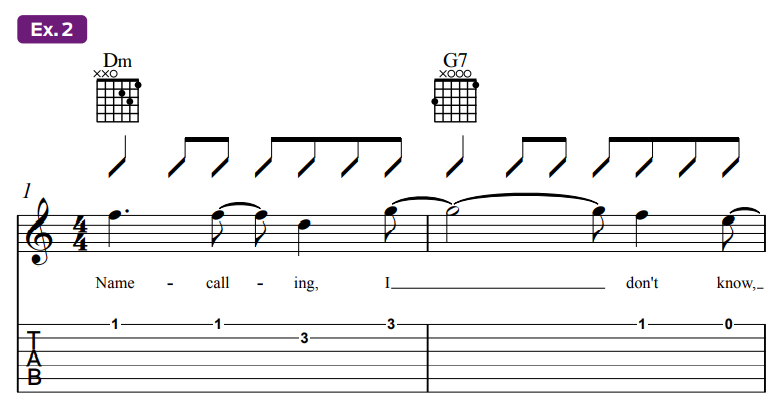
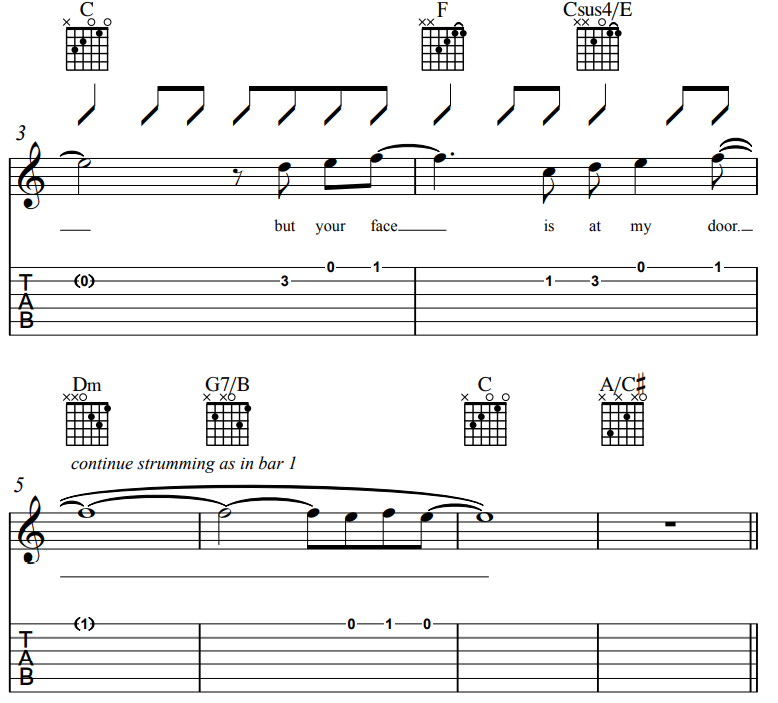
In the second chorus, there’s a G7/B chord that I always looked forward to playing (see Ex. 2, bar 6). There was just something about it. But there was no time to explore it because it was smack in the middle of the chorus. So I thought, Why not take that chord and create an entirely new section?
Sure, but how? I stopped and took a closer look. What did I like about that chord so much? Why did it catch my ear? Turns out it was the top two notes, D and F; I can’t explain why, but together they just resonated with me. So I kept them and started noodling (an underrated activity) until I had changed the bass note from B to C, resulting in a chord voicing I hadn’t played before – Csus2/4 (Ex. 3, bar 1).

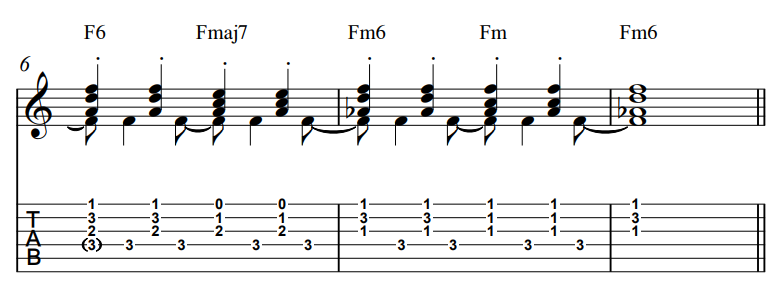
The suspended notes then lent themselves to resolving to a simple C chord, as you can see in the example. But adding this resolution made the original chord that had gotten me there, our friend G7/B, expendable, as I couldn’t create the same suspension/resolution theme I had hit upon. So I let it go. And doing so allowed me to find other chords with which I could create that same resolution.
While the end result was a common chord progression in the key of C – C - F - Fm – along with it came a new musical theme. Plus, I found myself playing a completely new rhythmic pattern by dropping the pick and plucking the strings with my fingers. Now I was onto something and quickly tied up any loose ends.
Was this inspiration? Yes, but of a different sort. In music, as in life, some things simply lead to others, and we just have to find our way to the place where we can make this happen. That is the crux of the approach: Out of one chord came an entirely new section, which doesn’t even have that chord in it anymore. Yet this new bridge is still directly related to the song’s DNA. All I did was stretch the Silly Putty.

Now, let’s take the same approach, this time to create an intro. One day, I stumbled onto the chorus for what would become a song called “Sunshine” (Ex. 4). I rode the wave and finished writing most of it. But when I found I was missing an intro, I again unconsciously looked inward to how I liked the way the guitar doubled most of the chorus vocal melody. Why not try to play the whole melody and make that the intro? So I did! And the result was the most boring intro you can imagine.
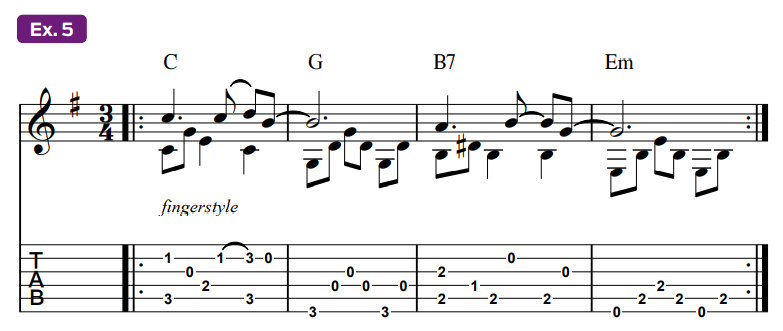
Still, I liked the idea of playing those chords with a melody on top. So I went back to noodling, and before I knew it, I had come up with a brand-new melody over the very same chords (Ex. 5). And this time, it had “intro” written all over it. Mission accomplished. But I wasn’t done yet, as surprisingly, I also found another higher melody using different voicings of the same chords, which became a brief interlude (Ex. 6).
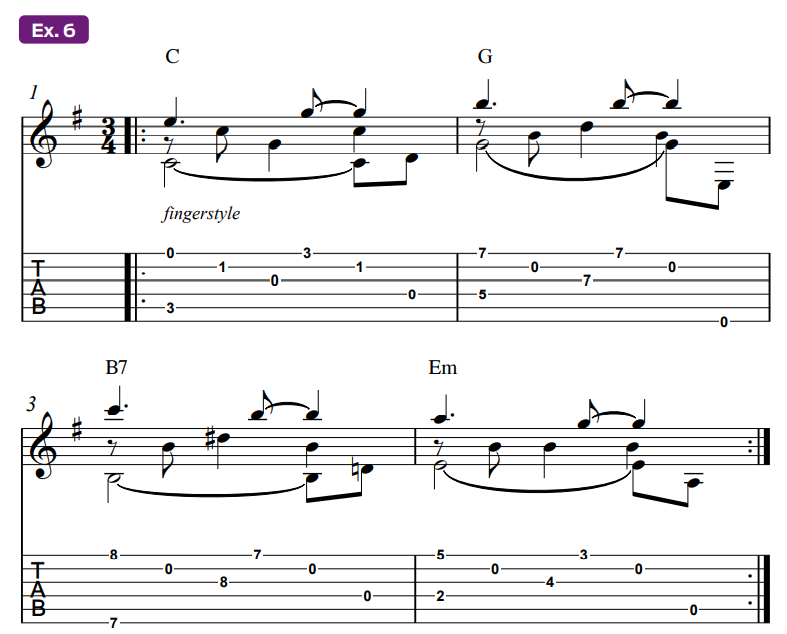
Throughout the song, I also play a short, two-bar theme based around an Eb/Bb chord, which takes the song somewhere new for a moment (Ex. 7).

For you theory heads, we’re in G major; Eb is the bVI chord, borrowed from the parallel minor key of G minor. When I was faced with the cold reality that I also needed a bridge, I fooled around with the Eb/Bb (also known as “noodling”) and found that the 2nd-string Eb - F melody was just begging to move up to G. Plus, I really liked the timbre of the droning open G string, so I was going to keep that for sure.
Looking back, even more than the Eb/ Bb chord itself, which I eventually left behind, it’s that simple droning open G note that ended up being the core of the new section. And along with the aforementioned G on the 2nd string, I now had two drones, an octave apart! I was off to the races, because drones immediately lend themselves to adding moving lines above or below them (think “bagpipes”). So I did just that, and in what seemed like no time, I had a sort of mini classical piece that serves as the song’s bridge (Ex. 8).
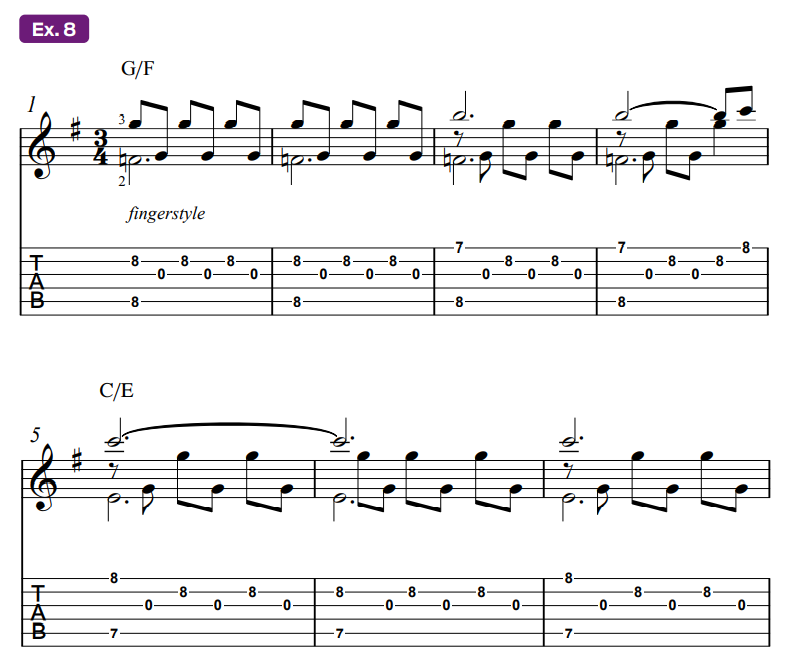
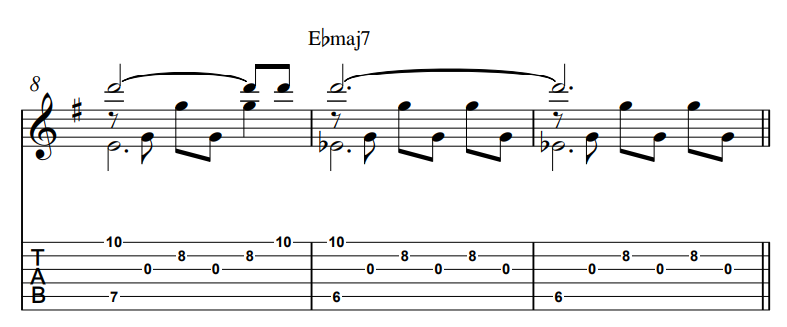
Now where did that come from? Like a matryoshka doll, it came from a simple open G string inside of a chord that I liked, inside of a section with no room to explore it. And that section was written way back during the original “big bang” of inspiration.
As songwriters, we are all faced with songs that have missing sections, with no inspiration in sight. But instead of immediately turning to an outside, Lego-type solution, it’s worth taking a step back to look for a small meaningful moment in the music you’ve already written. In many cases, it’s calling out to you.
Take that moment, get inside of it, and discover a new burst of inspiration. What’s different is this one doesn’t come looking for you; you have to find it. Oh, and don’t forget to noodle!
Jeff Jacobson is a guitarist, songwriter and veteran music transcriber, with hundreds of published credits. For information on virtual guitar and songwriting lessons or custom transcriptions, reach out to Jeff on Twitter @jeffjacobsonmusic or visit jeffjacobson.net.

